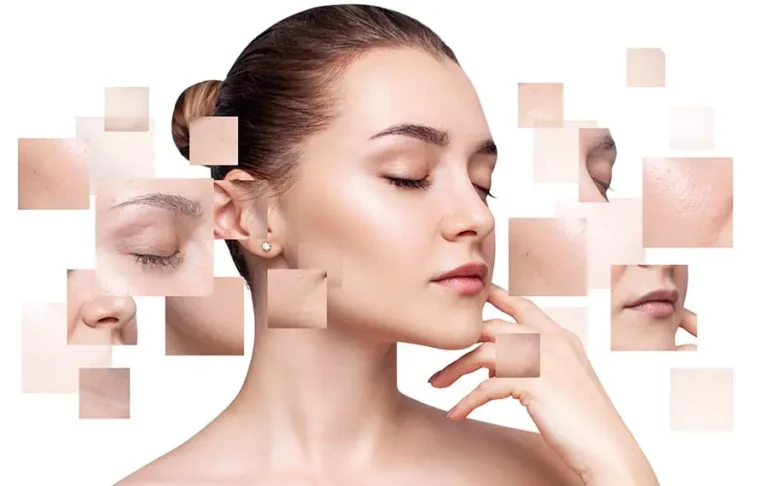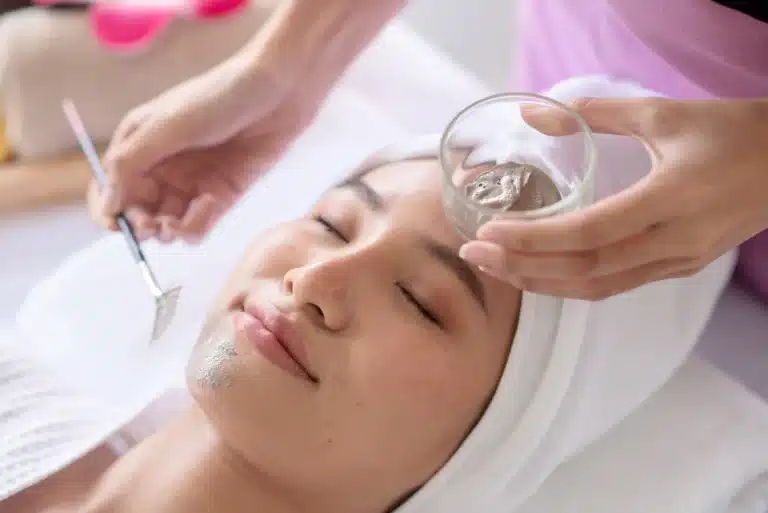Home » Conditions » Skin & hair » pigmentations
Skin pigmentation is a natural process determined by melanin, a pigment produced by cells called melanocytes. Melanin production is influenced by various factors. Dysfunctions in this process can cause the appearance of pigmented spots, which may be aesthetically bothersome. In fact, radiant and even skin without spots is a frequent request.
In most cases, skin pigmentations are harmless.
However, when brown spots appear, it is essential to consult a doctor for an accurate diagnosis.
Apart from naevi (moles), pigmented lesions may include :
• Age spots.
• Melasma.
• Freckles.
• Hyperpigmentation spots : caused by increased melanocyte activity following stimulation (trauma, pimple, medical procedure, application of chemical agents…).
• Spots secondary to a fungal infection.
Skin spots, whether brown spots, melasma, sun lentigines or hyperpigmentation, are a common aesthetic concern that affects the clarity and uniformity of the complexion. In aesthetic-oriented medicine, several treatments exist to correct these
skin imperfections and restore smooth, radiant skin. Pigment laser, chemical peels and depigmenting treatments effectively reduce pigment spots to achieve an even complexion.

A spot is the consequence of increased or irregular production of melanin by melanocytes.
Melanin is the pigment that gives skin its colour, and melanocytes are the cells responsible for its synthesis.
Pigmentation problems are caused by factors that influence this production.
• Sun exposure : UV rays stimulate melanin production, which is why we tan, but excessive production of this pigment causes persistent spots.
• Hormones : hormonal changes, especially during pregnancy or under contraceptives, play an important role in the appearance of melasma.
• Ageing : with age, cell renewal slows down and melanocyte activity becomes altered.
• Genetic factors.
• Skin inflammation : infections, acne, skin trauma and even certain aesthetic treatments can cause local inflammation that leads to pigmentation known as post-inflammatory.
The main depigmenting active ingredients used in aesthetics and in creams are :
• Hydroquinone : a powerful inhibitor of melanin production, it is very effective but its use is regulated to avoid the risk of irritation. It is found in onions, fruits, seeds, tea, coffee, beer and wine. Its use is allowed only in compounded prescriptions such as Kligman’s trio, and its use is currently prohibited in over-the-counter cosmetics.
• Arbutin : this is a derivative of hydroquinone found in cranberry and blueberry leaves.
• Kojic acid : derived from rice fermentation, it has natural brightening and antioxidant properties, acting gently on spots.
• Vitamin C : known for its antioxidant effects, this active ingredient lightens spots, stimulates collagen production and gives a more radiant complexion.
• Retinoids (vitamin A derivatives) : promote cell renewal, exfoliate the skin surface and reduce pigment spots.
• Azelaic acid : a gentle active ingredient suitable for sensitive skin that reduces hyperpigmentation and has anti-inflammatory properties.
• Tranexamic acid : an effective depigmenting agent, ideal for skin prone to melasma, thanks to its action on pigmentation and inflammation.
• Phytic acid : found in the husk of cereal seeds.
• Citric acid : derived from lemon.
• Niacinamide or vitamin B3 : found in plant roots and mushrooms.
These active ingredients are often combined to maximise their effectiveness and provide personalised solutions for a more even and radiant complexion.

To determine appropriate treatments, it is essential to distinguish the different types of pigment spots.
Aesthetic treatments for spots are effective solutions to reduce them and even out the complexion. Depending on the type of spot and the skin type.
Laser and chemical peels are the most effective methods.
It is important to understand that treatments remove the pigment but do not correct the dysfunction of melanocytes. The results are therefore temporary ; the pigmentation will reappear one or several years later depending on the patient’s lifestyle, especially sun exposure.

The depigmenting peel is an effective and non-invasive method to treat pigment spots and even out the complexion. Suitable for pigmentation issues such as melasma, solar lentigines and post-inflammatory pigmentation, this treatment is based on the application of powerful exfoliating agents, such as glycolic acid, trichloroacetic acid or kojic acid. These substances act by removing the superficial layers of the skin, thus promoting cell renewal and visibly reducing spots.
The combination of these active principles provides visible results, including a clear improvement in skin uniformity in 84 % of cases after 2 treatments, a strong reduction (72 %) in melasma, as well as smoother skin and less visible fine lines after several sessions for 83 % of patients.
Sun exposure is contraindicated for two months. The peel cannot be performed on tanned skin.
The choice of laser will depend on the type of spot and the depth of the pigmentation.
Two types of laser can be used :
• The depigmenting laser.
• The ablative laser.
The mechanism of action of depigmenting lasers is the use of a light beam with a very short pulse duration, on the order of the nanosecond, which makes it possible to fragment the pigment.
Depending on the depth of the pigment, a KTP Q-switched laser (epidermal pigment) or an Nd :YAG Q-switched laser (dermal pigment) is used.
A small scab may appear on the treated area, and the patient must keep it well moisturised daily. One or several sessions may be necessary.
Dr. Romano prefers to use the ablative laser. The mechanism of action of this laser is the vaporisation of the pigment. This treatment is more complex to perform, but it allows all types of pigmentation to be treated (the depigmenting laser is not indicated, for example, for the treatment of melasma).
The treatment with ablative laser, if correctly performed, does not cause post-inflammatory pigmentation. Indeed, even when used to remove spots, depigmenting lasers can cause local inflammation that worsens pigmentation.
It is possible to effectively prevent the appearance of pigment spots and maintain the skin’s natural radiance by adopting certain daily habits :
• Use daily sun protection : apply broad-spectrum sunscreen (minimum SPF 30) every day, even on cloudy days. This protects the skin from UV rays, the primary cause of pigmentation spots.
• Choose antioxidant-rich skincare : creams and serums containing vitamin C, vitamin E, or ferulic acid help neutralize free radicals that damage the skin and stimulate melanin production.
• Keep the skin well hydrated : proper hydration is essential for maintaining a healthy skin barrier, reducing inflammation and the risk of post-inflammatory pigmentation.
• Limit sun exposure : reduce time spent in the sun, especially between 10 a.m. and 4 p.m., and wear wide-brimmed hats and protective clothing to reduce the risk of brown spots.
• Use gentle skincare : avoid harsh products or treatments, as repeated inflammation or irritation can lead to post-inflammatory pigmentation.
• Use brightening ingredients preventively : ingredients such as vitamin C or azelaic acid help prevent melanin imbalance, even out the skin tone and reduce early pigmentation.
In Geneva, medical treatments aimed at reducing pigment spots start from 300 CHF per session. This base price applies regardless of the method used, whether laser or peel. The choice of technique depends on the depth and origin of the pigmentation. The cost per session may vary depending on the extent of the areas to be treated and the skin response observed.
A quote is provided during the first consultation, during which Dr. Romano explains the possible results, the cost of each session and the number of sessions required.
It is impossible to make pigment spots disappear naturally in just 3 days. However, some treatments can help lighten them : a lemon mask (rich in vitamin C) to brighten the skin, to be applied with caution (and never before sun exposure) ; aloe vera gel to soothe and regenerate the skin ; honey and turmeric masks, which have brightening properties.
However, these methods offer gradual results and require regular use.
Most pigment spots, such as sun lentigines or age spots, are benign and harmless. However, if a spot changes rapidly in shape, size or colour, it is recommended to consult a dermatologist to rule out any precancerous lesion.
The main factors are : excessive sun exposure without protection ; hormonal changes (pregnancy, contraception) ; certain photosensitising medications ; the natural ageing of the skin ; the lack of appropriate care, such as the absence of sun protection.
Yes, pigment spots can reappear, especially if sun protection is not rigorous. After a treatment such as a peel or a laser, it is essential to adopt an appropriate skincare routine and limit sun exposure to prevent recurrence.
Common pigmentation spots, such as solar lentigines, are benign and do not turn into cancer. However, regular monitoring is essential, as some precancerous skin lesions can resemble spots. In case of doubt, a dermatological consultation is recommended.
Pigment spots are melanin deposits, often flat and linked to sun exposure or age. Moles (or naevi) are clusters of pigment cells that can be flat or raised, with a uniform colour, and appear from childhood or adolescence. Any suspicious change in a mole requires medical evaluation.